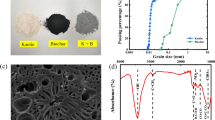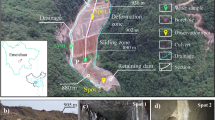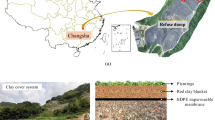Abstract
Kaolin and Bentonite the have potential to be used in landfill liners. Leachate in the landfill changes the properties of dispersion and sedimentation of the liners. There is a little research being conducted to investigate on how to reduce the influence of the salt on properties of clay. Soil salinity causes salt accumulation, detrimentally impacting soil structure degradation, impaired water infiltration, and consequent soil degradation. Despite the recognized efficacy of biochar (i.e., a carbon negative material) as a soil amendment for improving soil structure, its application to ameliorate saline-alkali soils remains insufficiently understood. This study attempted to improve the understanding of dispersion and sedimentation characteristics of saline clay soil under different porewater salinities (0%, 1%, 5%, 10%) and varying contents of biochar (0%, 5%, 10%). The results revealed that biochar-amended saline soil enhanced aggregation of dispersed soil particles, forming larger aggregates and promoting flocculation, effectively improving the dispersibility of clay and saline soil. The cation exchange capacity (CEC) of biochar is crucial for enhancing the soil aggregation in saline environments, countering the negative effects of high salt on soil structure. Biochar promotes soil particle aggregation by increasing CEC. At higher porewater salinities (i.e., 5%, 10%), the sedimentation property of soil particles in biochar was relatively inconsistent with expectations, exhibiting a slowed sediment rate and reduced soil sedimentation height. This difference was attributed to the adsorption of sodium ions by the functional groups and porous structure of biochar, decreasing the influence of salt addition dispersion and sedimentation characteristics. Based on these findings, it can be concluded that the application of biochar effectively enhanced soil physicochemical properties and improved soil structure.







Similar content being viewed by others
Data availability statement
Data are available upon reasonable request.
References
Wicke B, Smeets E, Dornburg V, Vashev B, Gaiser T, Turkenburg W, Faaij A (2011) The global technical and economic potential of bioenergy from salt-affected soils. Energy Environ Sci 4(8):2669–2681. https://doi.org/10.1039/c1ee01029h
Mcrobert J, Foley G (1999) The impacts of waterlogging and salinity on road assets: AWestern Australia case study. Special Report 57. https://trid.trb.org/view/612795
Xu G, Qi J, Jin H (2010) Model test study on influence of freezing and thawing on the crude oil pipeline in cold regions. Cold Reg Sci Technol 64(3):262–270. https://doi.org/10.1016/j.coldregions.2010.04.010
Zhang Z, Wu Q, Liu Y, Zhang Z, Wu G (2018) Thermal accumulation mechanism of asphalt pavement in permafrost regions of the Qinghai-Tibet Plateau. Appl Therm Eng 129:345–353. https://doi.org/10.1016/j.applthermaleng.2017.10.065
Leogrande R, Vitti C (2018) Use of organic amendments to reclaim saline and sodic soils: a review. Arid Land Res Manag 33(1):1–21. https://doi.org/10.1080/15324982.2018.1498038
Sahab S, Suhani I, Srivastava V, Chauhan PS, Singh RP, Prasad V (2021) Potential risk assessment of soil salinity to agroecosystem sustainability: Current status and management strategies. Sci Total Environ 764:144164. https://doi.org/10.1016/j.scitotenv.2020.144164
Amini S, Ghadiri H, Chen C, Marschner P (2015) Salt-affected soils, reclamation, carbon dynamics, and biochar: a review. J Soils Sediments 16(3):939–953. https://doi.org/10.1007/s11368-015-1293-1
Yan N, Marschner P, Cao W, Zuo C, Qin W (2015) Influence of salinity and water content on soil microorganisms. International Soil and Water Conservation Research 3(4):316–323. https://doi.org/10.1016/j.iswcr.2015.11.003
Hou Y, Zeng W, Hou M, Zhao W, Ying L, Lei G, Zhou B, Huang J (2021) Responses of the soil microbial community to salinity stress in maize fields. Biology 10(11):1114. https://doi.org/10.3390/biology10111114
Di Maio C (1996) Exposure of bentonite to salt solution: osmotic and mechanical effects. Geotechnique 46(4):695–707. https://doi.org/10.1680/geot.1996.46.4.695
Horpibulsuk S, Phojan W, Suddeepong A, Chinkulkijniwat A, Liu MD (2012) Strength development in blended cement admixed saline clay. Appl Clay Sci 55:44–52. https://doi.org/10.1016/j.clay.2011.10.003
Ying C, Hu X, Zhou C, Siddiqua S, Makeen GMH, Wang Q, Xu C (2020) Analysis of chemo-mechanical behavior of silty soil under long-term immersion in saline reservoir water. Bull Eng Geol Env 80(1):627–640. https://doi.org/10.1007/s10064-020-01928-2
Spagnoli G, Fernández-Steeger TM, Feinendegen M, Stanjek H, Azzam R (2010) The influence of the dielectric constant and electrolyte concentration of the pore fluids on the undrained shear strength of smectite. Soils Found 50(5):757–763. https://doi.org/10.3208/sandf.50.757
O’Laughlin J, McElligott K (2009) Biochar for Environmental Management: Science and Technology. Forest Policy Econ 11(7):535–536. https://doi.org/10.1016/j.forpol.2009.07.001
Ahmad M, Rajapaksha AU, Lim J, Zhang M, Bolan N, Mohan D, Vithanage M, Lee SS, Ok YS (2014) Biochar as a sorbent for contaminant management in soil and water: A review. Chemosphere 99:19–33. https://doi.org/10.1016/j.chemosphere.2013.10.071
Jien S, Wang CS (2013) Effects of biochar on soil properties and erosion potential in a highly weathered soil. CATENA 110:225–233. https://doi.org/10.1016/j.catena.2013.06.021
Meng Q, Ma X, Zhang J, Yu Z (2019) The long-term effects of cattle manure application to agricultural soils as a natural-based solution to combat salinization. CATENA 175:193–202. https://doi.org/10.1016/j.catena.2018.12.022
Sun X, She D, Fei Y, Wang H, Gao L (2021) Three-dimensional fractal characteristics of soil pore structure and their relationships with hydraulic parameters in biochar-amended saline soil. Soil and Tillage Research 205:104809. https://doi.org/10.1016/j.still.2020.104809
Tomczyk A, Sokołowska Z, Boguta P (2020) Biochar physicochemical properties: pyrolysis temperature and feedstock kind effects. Reviews in Environmental Science and Bio/Technology 19(1):191–215. https://doi.org/10.1007/s11157-020-09523-3
Qin C, Wang H, Yuan X, Xiong T, Zhang J, Zhang J (2020) Understanding structure-performance correlation of biochar materials in environmental remediation and electrochemical devices. Chem Eng J 382:122977. https://doi.org/10.1016/j.cej.2019.122977
Cogger C (2005) Potential Compost Benefits for Restoration Of Soils Disturbed by Urban Development. Compost Science And Utilization 13(4):243–251. https://doi.org/10.1080/1065657x.2005.10702248
Głąb T, Palmowska J, Zaleski T, Gondek K (2016) Effect of biochar application on soil hydrological properties and physical quality of sandy soil. Geoderma 281:11–20. https://doi.org/10.1016/j.geoderma.2016.06.028
Leng L, Liu R, Xu S, Mohamed BA, Yang Z, HU Y, Chen J, Zhao S, Wu Z, Peng H, LI H, LI H, (2022) An overview of sulfur-functional groups in biochar from pyrolysis of biomass. J Environ Chem Eng 10(2):107185. https://doi.org/10.1016/j.jece.2022.107185
Yang Q, Wu L, Zheng Z, Chen J, Lu T, Lu M, Chen W, Qi Z (2022) Sorption of Cd(II) and Ni(II) on biochars produced in nitrogen and air-limitation environments with various pyrolysis temperatures: Comparison in mechanism and performance. Colloids Surf, A 635:28100. https://doi.org/10.1016/j.colsurfa.2021.128100
Mandal S, Pu S, Adhikari S, Ma H, Kim D, Bai Y, Hou D (2020) Progress and prospects in biochar composites: Application and reflection in the soil environment. Crit Rev Environ Sci Technol 51(3):219–271. https://doi.org/10.1080/10643389.2020.1713030
Li J, Li B, Huang H, Zhao N, Zhang M, Cao L (2020) Investigation into lanthanum-coated biochar obtained from urban dewatered sewage sludge for enhanced phosphate adsorption. Sci Total Environ 714:136839. https://doi.org/10.1016/j.scitotenv.2020.136839
Castellini M, Giglio L, Niedda M, Palumbo A, Ventrella D (2015) Impact of biochar addition on the physical and hydraulic properties of a clay soil. Soil And Tillage Research 154:1–13. https://doi.org/10.1016/j.still.2015.06.016
Santos WMD, Gonzaga MIS, Da Silva JA, De Almeida AQ, Santos JC, TaS G, Da Silva LI, Araújo EM (2021) Effectiveness of different biochars in remediating a salt-affected Luvisol in Northeast Brazil. Biochar 3(2):149–159. https://doi.org/10.1007/s42773-020-00084-w
Ghezzehei TA, Sarkhot DV, Berhe AA (2014) Biochar can be used to capture essential nutrients from dairy wastewater and improve soil physico-chemical properties. Solid Earth 5(2):953–962. https://doi.org/10.5194/se-5-953-2014
Xu Z, Jisong Q, Li H, La S, Tian Y, Gao L (2020) Biochar addition combined with daily fertigation improves overall soil quality and enhances water-fertilizer productivity of cucumber in alkaline soils of a semi-arid region. Geoderma 363:14170. https://doi.org/10.1016/j.geoderma.2019.114170
Liu X, Zhang X, Kong L, Wang G, Lu J (2022) Disintegration of granite residual soils with varying degrees of weathering. Eng Geol 305:106723. https://doi.org/10.1016/j.enggeo.2022.106723
Goodarzi A, Fateh SN, Shekary H (2016) Impact of organic pollutants on the macro and microstructure responses of Na-bentonite. Appl Clay Sci 121–122:17–28. https://doi.org/10.1016/j.clay.2015.12.023
Au P, Leong Y (2013) Rheological and zeta potential behaviour of kaolin and bentonite composite slurries. Colloids Surf, A 436:530–541. https://doi.org/10.1016/j.colsurfa.2013.06.039
Wang H, She D, Fei Y, Tang S (2019) Synergic effects of biochar and polyacrylamide amendments on the mechanical properties of silt loam soil under coastal reclamation in China. CATENA 182:104152. https://doi.org/10.1016/j.catena.2019.104152
Meshram K, Rao BH, Reddy KR (2018) Biopolymer amendment for mitigating dispersive characteristics of red mud waste. Geotechnique Letters 8(3):201–207. https://doi.org/10.1680/jgele.18.00033
Liang J, Li Y, Si B, Wang Y, Chen X, Wang X, Chen H, Wang H, Zhang F, Bai Y, Biswas A (2021) Optimizing biochar application to improve soil physical and hydraulic properties in saline-alkali soils. Sci Total Environ 771:144802. https://doi.org/10.1016/j.scitotenv.2020.144802
Alam S, Das BK, Das SK (2018) Dispersion and sedimentation characteristics of red mud. Journal of Hazardous, Toxic, and Radioactive Waste. https://doi.org/10.1061/(asce)hz.2153-5515.0000420
Xiao L, Cai W, Satyam N, Garg A (2023) Effect of biochar produced from peach pit biomass on sedimentation, water retention, and volumetric shrinkage behavior of saline kaolin clay. Biomass Conversion and Biorefinery. https://doi.org/10.1007/s13399-023-04253-2
ASTM D 422-63 (Reapproved 2002) (2002) Standard test method for particle size analysis of soils. ASTM International, West Conshohocken, PA, United States. https://doi.org/10.1520/D0422-63R98
ASTM D854–02 (2002) Standard test methods for specific gravity of soil solids by water Pycnometer. (ASTM International) West Conshohocken, PA, United States.
ASTM D4318–00 (2000) Standard test methods for liquid limit, plastic limit, and plasticity index of soils. American Society for Testing and Materials. ASTM West Conshohocken, PA USA. D854–02. https://doi.org/10.1520/D4318-00
Ma S, Wang X, Wang S, Feng K (2022) Effects of temperature on physicochemical properties of rice straw biochar and its passivation ability to Cu2+ in soil. J Soils Sediments 22(5):1418–1430. https://doi.org/10.1007/s11368-022-03144-9
Omar N, Abdullah EC, Petrus AA, Mubarak NM, Khalid M, Agudosi ES, Numan A, Aid SR (2021) Single-route synthesis of binary metal oxide loaded coconut shell and watermelon rind biochar: Characterizations and cyclic voltammetry analysis. Biomass Conversion and Biorefinery 13(3):2279–2291. https://doi.org/10.1007/s13399-021-01367-3
Novak JM, Lima I, Xing B, Gaskin JW, Steiner C, Das KC, Ahmedna M, Rehrah D, Watts DW, Busscher WJ, Schomberg H (2022) Characterization of designer biochar produced at different temperatures and their effects on a loamy sand. Annals of Environmental Science 3:195–206
Monteiro C, AaF Z, Ferreira SRS (2022) From Biorefinery to Food Product Design: Peach (Prunus persica) By-Products Deserve Attention. Food Bioprocess Technol 16(6):1197–1215. https://doi.org/10.1007/s11947-022-02951-9
Nair V, Vinu R (2016) Peroxide-assisted microwave activation of pyrolysis char for adsorption of dyes from wastewater. Biores Technol 216:511–519. https://doi.org/10.1016/j.biortech.2016.05.070
Creamer AE, Gao B, Zhang M (2014) Carbon dioxide capture using biochar produced from sugarcane bagasse and hickory wood. Chem Eng J 249:174–179. https://doi.org/10.1016/j.cej.2014.03.105
Chen Y, Yang H, Wang X, Chen W, Chen H (2016) Biomass Pyrolytic Polygeneration System: adaptability for different feedstocks. Energy Fuels 30(1):414–422. https://doi.org/10.1021/acs.energyfuels.5b02332
Xiong Z, Zheng H, Wu J, Chen W, Chen Y, Gao X, Yang H, Chen H (2021) Physicochemical and adsorption properties of biochar from biomass-based pyrolytic polygeneration: effects of biomass species and temperature. Biochar 3(4):57–670. https://doi.org/10.1007/s42773-021-00102-5
He M, Xu Z, Sun Y, Chan PS, Lui I, Tsang DC (2021) Critical impacts of pyrolysis conditions and activation methods on application-oriented production of wood waste-derived biochar. Biores Technol 341:125811. https://doi.org/10.1016/j.biortech.2021.125811
Xu Z, He M, Xu X, Cao X, Tsang DC (2021) Impacts of different activation processes on the carbon stability of biochar for oxidation resistance. Biores Technol 338:125555. https://doi.org/10.1016/j.biortech.2021.125555
Li S, Barreto V, Li R, Chen G, Hsieh YP (2018) Nitrogen retention of biochar derived from different feedstocks at variable pyrolysis temperatures. J Anal Appl Pyrol 133:136–146. https://doi.org/10.1016/j.jaap.2018.04.010
Yu Z, Chen L, Pan S, Li Y, Kuzyakov Y, Xu J, Brookes PC, Luo Y (2018) Feedstock determines biochar-induced soil priming effects by stimulating the activity of specific microorganisms. Eur J Soil Sci 69(3):21–534. https://doi.org/10.1111/ejss.12542
Li S, Harris SR, Anandhi A, Chen G (2019) Predicting biochar properties and functions based on feedstock and pyrolysis temperature: A review and data syntheses. J Clean Prod 215:890–902. https://doi.org/10.1016/j.jclepro.2019.01.106
Agrafioti E, Bouras G, Kalderis D et al (2013) Biochar production by sewage sludge pyrolysis. J Anal Appl Pyrol 101:72–78. https://doi.org/10.1016/j.jaap.2013.02.010
Wong JTF, Chen Z, Wong AYY, Ng CWW, Wong MH (2018) Effects of biochar on hydraulic conductivity of compacted kaolin clay. Environ Pollut 234:68–472. https://doi.org/10.1016/j.envpol.2017.11.079
Das P, Bharat TV (2021) Kaolin based protective barrier in municipal landfills against adverse chemo-mechanical loadings. Sci Rep. https://doi.org/10.1038/s41598-021-89787-z
Zhou Y, Huang M, Deng Q, Cai T (2017) Combination and performance of forward osmosis and membrane distillation (FO-MD) for treatment of high salinity landfill leachate. Desalination 420:99–105. https://doi.org/10.1016/j.desal.2017.06.027
ASTM D6572–21(2020) Standard Test Methods for Determining Dispersive Characteristics of Clayey Soils by the Crumb Test. ASTM International, West Conshohocken, PA, United States. https://doi.org/10.1520/D6572-21
Palomino AM, Santamarina JC (2005) Fabric map for kaolinite: effects of pH and ionic concentration on behavior. Clays Clay Miner 53(3):211–223. https://doi.org/10.1346/ccmn.2005.0530302
Yan WM, Chang J (2015) Effect of pore water salinity on the coefficient of earth pressure at rest and friction angle of three selected fine-grained materials. Eng Geol 193:153–157. https://doi.org/10.1016/j.enggeo.2015.04.025
Tiwari B, Ajmera B (2014) Effects of saline fluid on compressibility of clay minerals. Environmental Geotechnics 1(2):108–120. https://doi.org/10.1680/envgeo.13.00053
Su X, Wu W, Tang H, Huang L, Xia D, Lu S (2023) Physicochemical effect on soil in sliding zone of reservoir landslides. Eng Geol 324:107249. https://doi.org/10.1016/j.enggeo.2023.107249
Kim HS, Kim KR, Yang JE, Ok YS, Owens G, Nehls T, Wessolek G, Kim KH (2016) Effect of biochar on reclaimed tidal land soil properties and maize (Zea mays L.) response. Chemosphere 142:153–159. https://doi.org/10.1016/j.chemosphere.2015.06.041
Chen R, Zhang L, Budhu M (2013) Biopolymer stabilization of mine tailings. Journal of Geotechnical and Geoenvironmental Engineering 139(10):1802–1807. https://doi.org/10.1061/(asce)gt.1943-5606.0000902
Kim J, Kim H, Baek K (2023) Novel electrochemical method to activate biochar derived from spent coffee grounds for enhanced adsorption of lead (Pb). Sci Total Environ 886:163891. https://doi.org/10.1016/j.scitotenv.2023.163891
Zheng H, Wang X, Luo X, Wang Z, Xing B (2018) Biochar-induced negative carbon mineralization priming effects in a coastal wetland soil: Roles of soil aggregation and microbial modulation. Sci Total Environ 610–611:951–960. https://doi.org/10.1016/j.scitotenv.2017.08.166
Cheng C, Lehmann J, Thies JE, Burton SD, Engelhard MH (2006) Oxidation of black carbon by biotic and abiotic processes. Org Geochem 37(11):1477–1488. https://doi.org/10.1016/j.orggeochem.2006.06.022
Six J, Bossuyt H, DeGryze S, Denef K (2004) A history of research on the link between (micro)aggregates, soil biota, and soil organic matter dynamics. Soil & Tillage Research 79(1):7–31. https://doi.org/10.1016/j.still.2004.03.008
Gunarathne V, Senadeera A, Gunarathne U, Biswas JK, Almaroai YA, Vithanage M (2020) The potential of biochar and organic amendments for reclamation of coastal acidic-salt-affected soil. Biochar 2(1):107–120. https://doi.org/10.1007/s42773-020-00036-4
Liu XH, Han FP, Zhang XC (2012) Effects of biochar on soil aggregates in the Loess Plateau: results from incubation experiments. Int J Agric Biol 14:975–979
Trompowsky PM, Benites DM, V, Madari BE, Pimenta AS, Hockaday WC, Hatcher, PG, (2005) Characterization of humic like substances obtained by chemical oxidation of eucalyptus charcoal. Org Geochem 36(11):1480–1489. https://doi.org/10.1016/j.orggeochem.2005.08.001
Zhang T, Deng Y, Cui Y, Lan H, Zhang F, Zhang H (2019) Porewater salinity effect on flocculation and desiccation cracking behaviour of kaolin and bentonite considering working condition. Eng Geol 251:1–23. https://doi.org/10.1016/j.enggeo.2019.02.007
Sides GR, Barden L (1971) The microstructure of dispersed and flocculated samples of kaolinite, illite, and montmorillonite. Can Geotech J 8(3):391–399. https://doi.org/10.1139/t71-041
Mitchell JK (1956) The fabric of natural clays and its relation to engineering properties. Highway Research Board Proceedings 35. https://trid.trb.org/view/121606
Salehi M (2009) Lime-clay modification and its application in the construction of man-made islands. Dissertation, University of James Cook.
Głodowska M, Husk B, Schwinghamer T, Smith DL (2016) Biochar is a growth-promoting alternative to peat moss for the inoculation of corn with a pseudomonad. Agron Sustain Dev. https://doi.org/10.1007/s13593-016-0356-z
Acknowledgements
The authors would like to acknowledge the National Natural Science Foundation (No. 52261160382) for their support.
Funding
The authors would like to acknowledge the National Natural Science Foundation (No. 52261160382) for their support. National Natural Science Foundation of China,52261160382), Ankit Garg
Author information
Authors and Affiliations
Contributions
Chunhui Yan and Lina Xiao completed the experiment together. Chunhui Yan wrote the main manuscript text and prepared figures. Lina Xiao revised the manuscript. Ankit Garg revised the final manuscript. All authors reviewed the manuscript.
Corresponding author
Ethics declarations
Conflict of Interest
The authors declare that there is no conflict of interest with anyone.
Additional information
Publisher's Note
Springer Nature remains neutral with regard to jurisdictional claims in published maps and institutional affiliations.
Rights and permissions
Springer Nature or its licensor (e.g. a society or other partner) holds exclusive rights to this article under a publishing agreement with the author(s) or other rightsholder(s); author self-archiving of the accepted manuscript version of this article is solely governed by the terms of such publishing agreement and applicable law.
About this article
Cite this article
Yan, C., Xiao, L., Garg, A. et al. Effect of Pyrolyzed Peach Pit Biomass on Dispersion and Sedimentation Characteristics of Saline Clay. Indian Geotech J (2024). https://doi.org/10.1007/s40098-024-00973-y
Received:
Accepted:
Published:
DOI: https://doi.org/10.1007/s40098-024-00973-y




